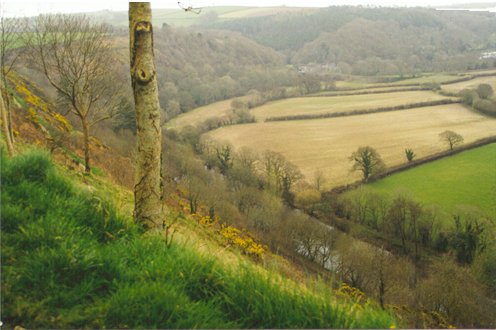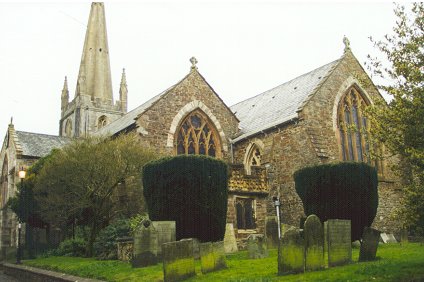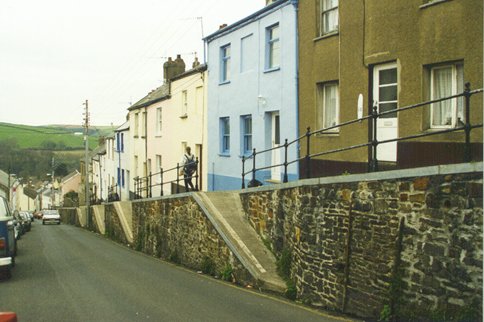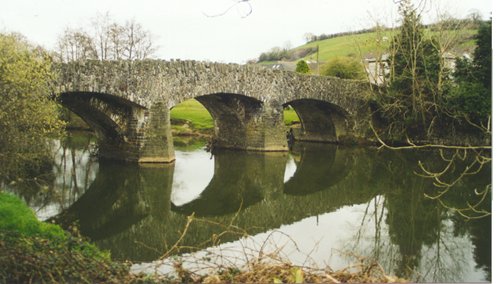GREAT TORRINGTON |
|
Great Torrington (usually just called Torrington) was the home of the Bulley family from at least 1793 to 1799 and probably quite a bit longer. Nicholas Bulley and his siblings Frances and Charles were born there, baptised in the parish church of St Michael and All Angels and probably grew up there. Their baptismal dates were:- Frances 20th October 1793, Charles 16th January 1796 and Nicholas 29th September 1799. Their parents were William and Frances Bulley. William's occupation was given as a painter. I do not know what kind of painter William Bulley was. He certainly travelled around quite a lot in his lifetime before he settled in Torrington. Was this looking for clients? Perhaps Torrington provided sufficient clients for him to be able to settle there. If, on the other hand, he painted landscapes then he had plenty of beauty to paint in Torrington and its surroundings. I have several books with guides to British towns and Tours of Britain as well as the Domesday Book but there was very little information in any of them about Torrington. This amazes me for I have visited it now (in March 1999) and found it not only a very attractive town in a spectacular situation but a town with a great deal of history and interest. The town is perched high on a steep hill above the River Torridge with wonderful views around the surrounding countryside as it occupies one of the finest sites in Devon. The distant views towards and from the town are superb. The little market square has considerable charm. Buildings of interest include the Georgian town hall, the early Victorian market-house and the Black Horse Inn which is still partly 16th century. |
|
|
|
The town itself is surrounded on three sides by extensive common land which was donated `for the relief of the poor' at the end of the 12th century by Baron FitzRobert of Torrington. This is now administered by a body called `The Commons Conservators'. It is an area which covers some 365 acres and has over 20 miles of public footpaths and rights of way. It is very attractive and a wonderful asset to the people of Great Torrington as a place of beauty to walk, picnic, study the variety of interesting habitats for flora and fauna or just sit and admire the view, as it is high above the surrounding countryside. Many interesting wildflowers and butterflies can be found there as well as otters (by the Torridge) and other wildlife. I wonder if the Bulley family wandered along the paths in this common land, picnicked and looked for the wildlife there? |
|
|
|
The most dramatic night in Torrington's long history was in the seventeenth century during the Civil war between King Charles I and Oliver Cromwell. Torrington had been occupied by a Royalist army under the command of Lord Hopton. It was the last army remaining to the King, his main army having been destroyed at Naseby in June 1645. The leaders of the Parliamentary forces, Fairfax and Cromwell, decided to attack this last Royalist stronghold and thus put an end to the King's hopes of continuing the war. They attacked the town during the night of the 16th February 1646 and, after a hard fight, the Royalists fled in the direction of Cornwall after several hundred being killed and having two or three hundred of their men taken prisoner. The Parliamentarians shut these prisoners up in the church, the only building in the town capable of holding such a large number, not knowing that the Royalists had stored all their gunpowder in it. There were still about eighty barrels there in the church. What exactly happened during the night will never be known. Perhaps one of the wretched prisoners sat down in the dark on a damaged barrel and took out his tinder box to light his pipe: perhaps someone dropped a candle; no doubt it was not done on purpose but somehow or other the church was blown up, the explosion killing most of the prisoners and their guards. A long mound on the south side of the church is thought to be their mass grave. The church was re-built in 1651 and is today the Parish Church of St Michael & All Angels. It is where Nicholas Bulley, our ancestor, was baptised. |
|
|
|
This, of course, happened long before our Bulleys were in Torrington but I expect that they knew about it. Today this last battle between the Royalists and Roundheads is re-enacted each year as a tourist attraction. Everyone who wishes, dresses up in the costume of whichever side they want to support and a mock battle is fought. The history of Torrington of course goes back much further than the 17th century. Its good strategic position would have been recognised very early on. The town is first mentioned in the Domesday Book. It is not actually known when the Normans first constructed a castle in Torrington and in any case it was destroyed in 1228 by the order of Henry II along with hundreds of other castles which had been built in the time of the civil war between Steven and Matilda. The castle was re-built by Richard de Merton in the 14th century but what its purpose was is unknown as the next 300 years must have been relatively peaceful and the fortifications receive no mention in the accounts of engagements of the Royalist and Roundhead civil war. Today there is not a great deal to be seen of the castle although it is sited in a position at the top of Castle Hill and has uninterrupted views over the valleys to the high ground around Torrington. The last surviving part of the castle, the chapel, became Torrington's school in 1780 and today (1999) it is a Community Centre. |
|
|
|
|





